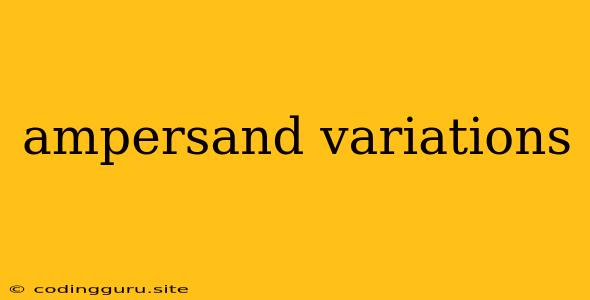The Many Faces of the Ampersand: A Comprehensive Guide to its Variations
The ampersand (&), a seemingly simple symbol, boasts a surprising array of variations. Its history is as rich and diverse as the languages it has graced, each iteration carrying its own unique story. But why so many variations? What are the differences, and how do they impact usage?
Tracing the Origins: From Ligature to Symbol
The ampersand's journey began as a ligature, a shorthand way of combining the letters "et" in Latin, meaning "and." Over time, this ligature evolved into a distinct symbol, acquiring its own name: the ampersand.
A Visual Feast: Exploring the Variations
1. The Classic Ampersand: This is the most familiar form, a stylized "E" with a looped tail. Its origins lie in cursive handwriting, where "et" would often be joined together.
2. The Script Ampersand: This version appears more hand-drawn, with a cursive-like flow, and is commonly used in fonts with a calligraphic style.
3. The Serif Ampersand: This ampersand features serifed edges, adding a touch of formality and traditional elegance.
4. The Sans-Serif Ampersand: In contrast, this ampersand lacks serifs, giving it a clean, modern look.
5. The Blackletter Ampersand: This variation, inspired by medieval blackletter fonts, is characterized by intricate flourishes and a decorative aesthetic.
6. The Monospaced Ampersand: This ampersand, found in monospaced fonts, maintains a fixed width, making it suitable for coding and technical documents.
Choosing the Right Ampersand: When Form Meets Function
Selecting the appropriate ampersand is a matter of both aesthetics and context.
-
Formal vs. Informal: A classic ampersand is typically preferred for formal documents and publications, while more stylized versions might suit informal or creative projects.
-
Font Style: The ampersand you choose should complement the font's overall design. A blackletter ampersand would feel jarring in a modern sans-serif font, while a script ampersand might enhance the elegance of a calligraphic typeface.
-
Visual Appeal: Consider the visual impact of the ampersand. A bold, pronounced ampersand can draw attention, while a subtle variation might blend seamlessly with the surrounding text.
Beyond the Basics: The Ampersand in Action
The ampersand's versatility extends beyond simply replacing the word "and."
-
Company Names: The ampersand has become a staple in company names, often used to convey a sense of partnership or collaboration.
-
Branding: Brands frequently incorporate the ampersand into their logos, evoking a sense of tradition, sophistication, or a unique character.
-
Design: From graphic design to web design, the ampersand's visual appeal makes it a popular decorative element.
The Ampersand's Enduring Legacy
From its humble beginnings as a ligature, the ampersand has evolved into a versatile symbol, embracing both tradition and innovation. Whether used in formal documents, creative projects, or branding efforts, its presence enriches the written and visual landscape.
Conclusion
The ampersand, with its diverse variations, offers a fascinating glimpse into the history of language and design. Its enduring popularity speaks volumes about its versatility, beauty, and enduring appeal. Whether you're a writer, designer, or simply a lover of language, understanding the ampersand's history and its variations can enhance your appreciation for its subtle nuances and enduring legacy.
